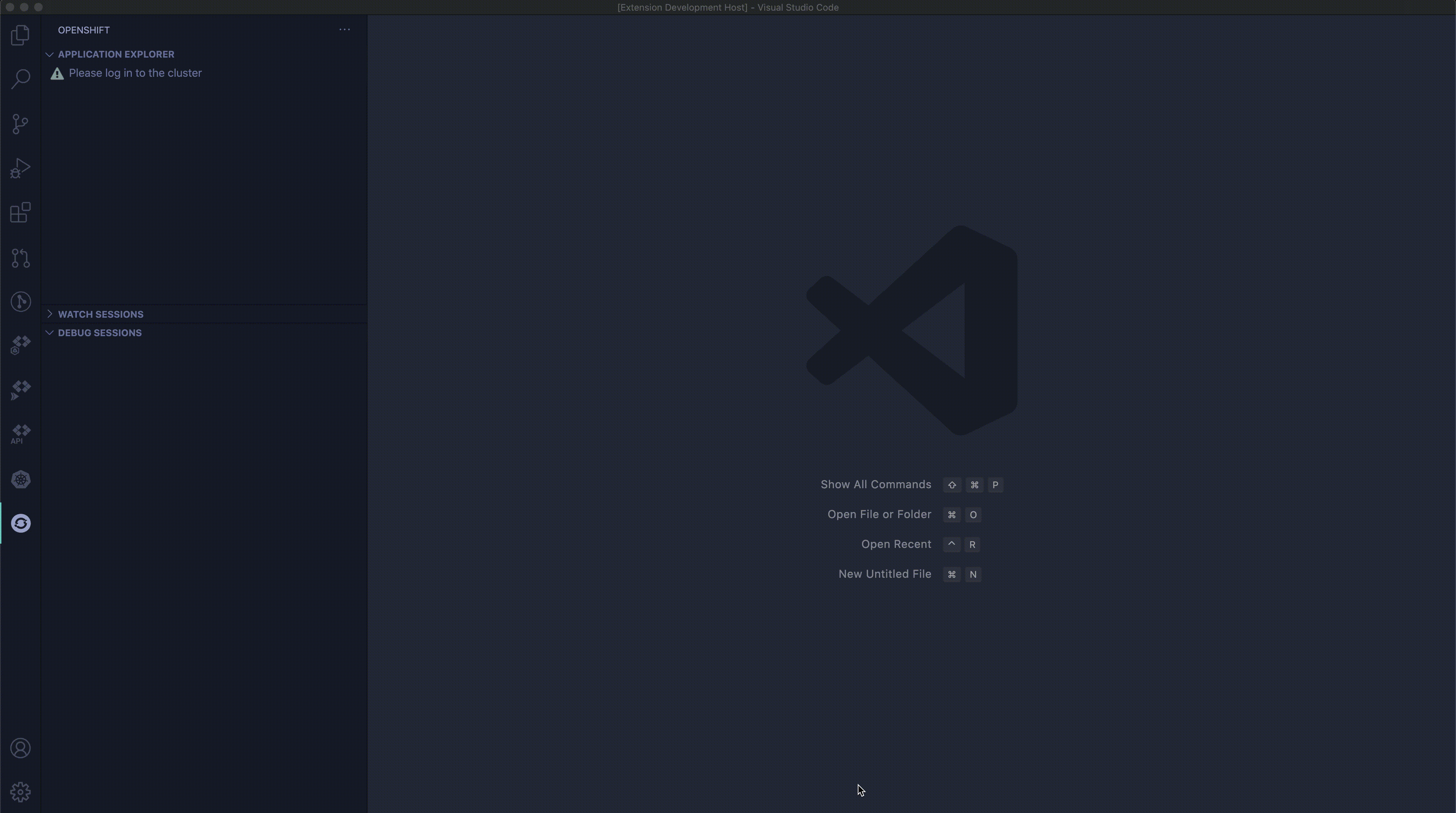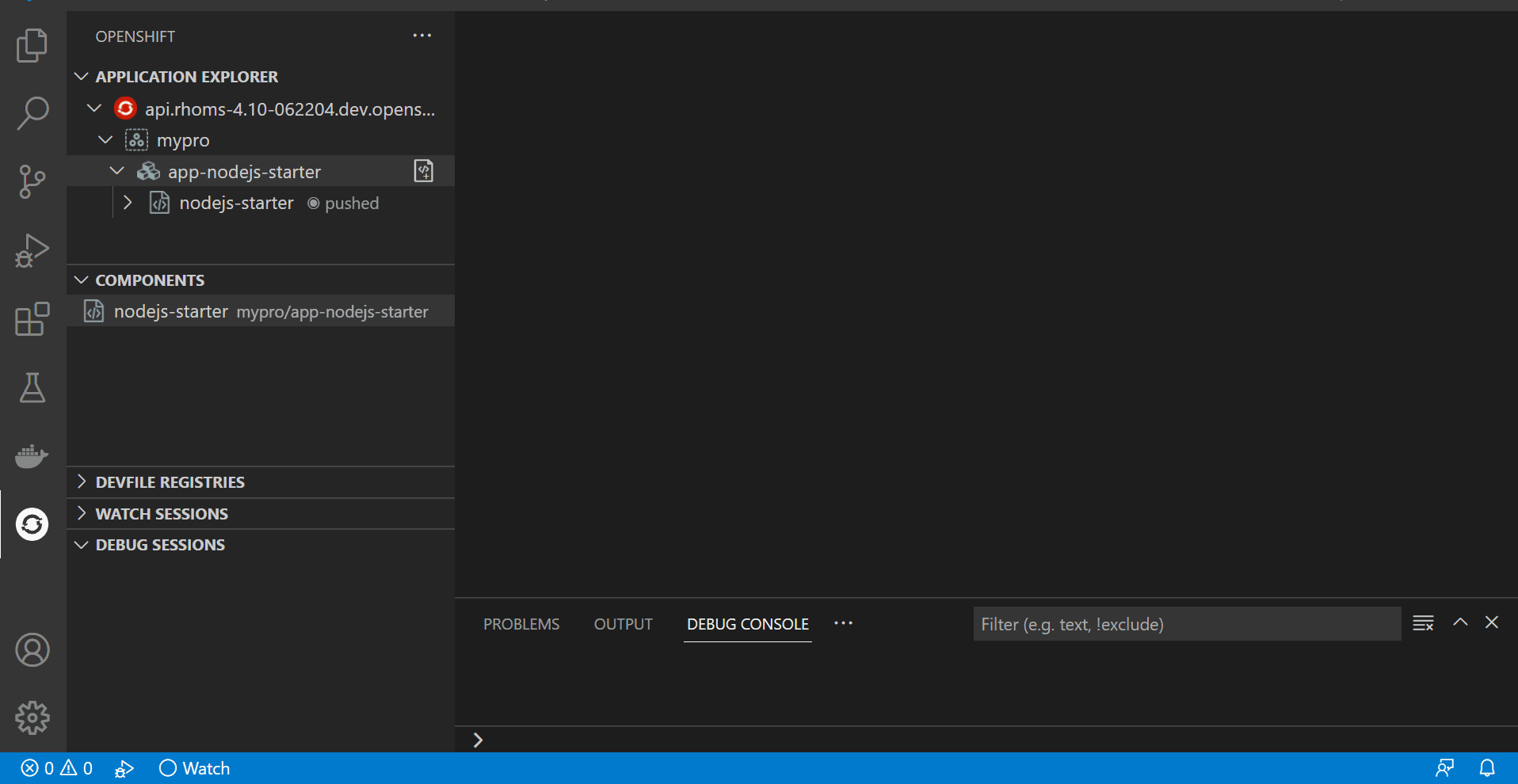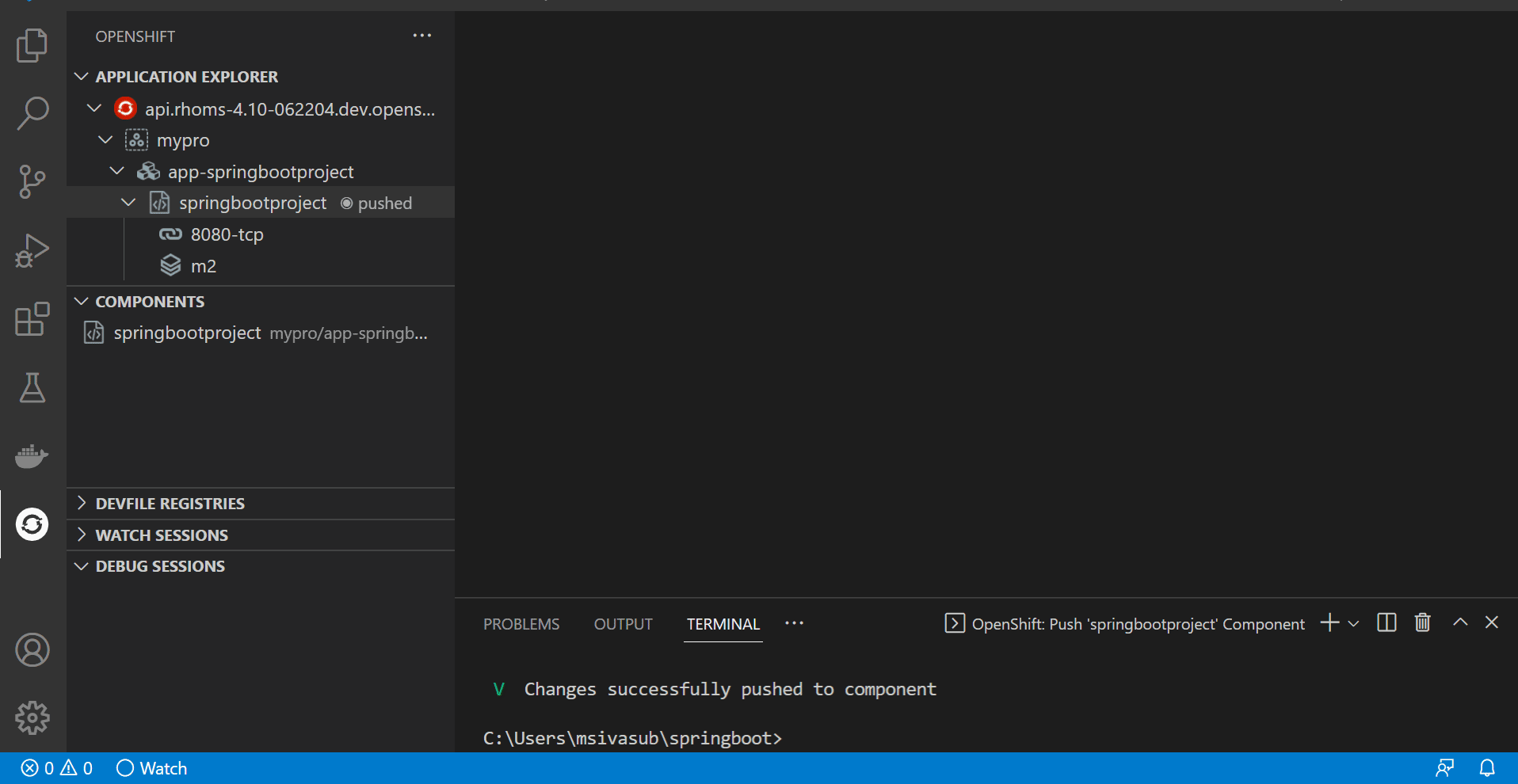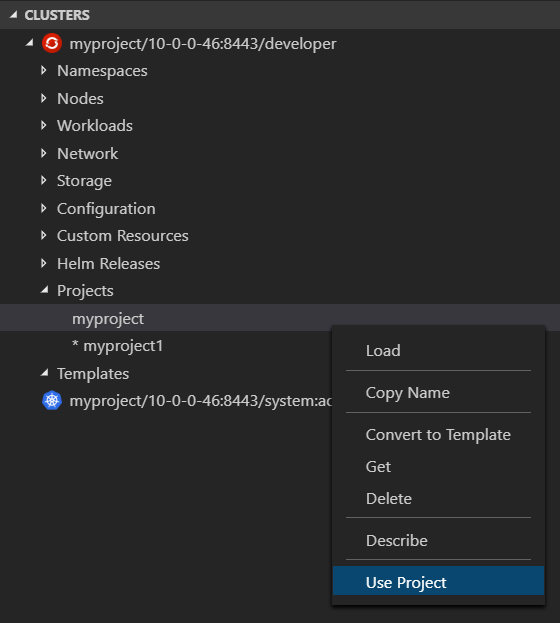redhat-developer / Vscode Openshift Tools
Programming Languages
Projects that are alternatives of or similar to Vscode Openshift Tools
OpenShift Connector
Overview
OpenShift Connector extension provides an end-to-end developer experience for Red Hat® OpenShift®. Using this extension:
- Developers can easily create, deploy and live debug applications running on OpenShift.
- Run local instance of OpenShift 4.7 using Red Hat CodeReady Containers.
New and noteworthy
- View to browse Component Catalog and Registries (see #1931)
- View to show Components in current workspace (see #2008)
- Reveal in Explorer command to navigate from Component item in Components View to the component's source code
- Create Components while logged off Cluster
- Supports creation of local OpenShift Cluster 4.7.0
- OKD CLI v4.6.17 included
- ODO CLI v2.0.7 included
Demo: https://www.youtube.com/watch?v=HEsYgDqD1rM
Supported OpenShift Clusters
Developer Sandbox
The extension allows users free access to the Developer Sandbox for Red Hat OpenShift. From Add Cluster View, users will be redirected to the dev sandbox instance. The sandbox provides you with a private OpenShift environment in a shared, multi-tenant OpenShift cluster that is pre-configured with a set of developer tools.
Local instance of OpenShift
This extension can work with local or remote OpenShift clusters.
To provision local instance of OpenShift cluster, developers can use the following options:
- Red Hat CodeReady Containers - run single node local OpenShift 4.x cluster
- minishift / CDK - run single node local OpenShift 3.x cluster
For detail analysis of how to setup and run local OpenShift Cluster using minishift, please follow this wiki.
Public cloud providers
If developers can't run OpenShift cluster locally, the extension can work with remote one provisioned with one of Red Hat products:
- Red Hat OpenShift Container Platform - build, deploy and manage your applications across cloud- and on-premise infrastructure
- Red Hat OpenShift Dedicated - single-tenant, high-availability Kubernetes clusters in the public cloud
- Microsoft Azure Red Hat OpenShift - fully managed Red Hat OpenShift service on Microsoft Azure
- Red Hat OpenShift Online - the fastest way for developers to build, host and scale applications in the public cloud
To install OpenShift Container Platform 4 in the public cloud, in your datacenter or on your laptop please visit Red Hat OpenShift Cluster Manager.
NOTE: When working with Red Hat OpenShift Online remote cluster only one component can be created for Starter plan and Pro plan with default 2GiB storage. If you want to create multi component application you could opt in for Pro plan with bigger persistence storage (up to 150GiB).
Core Concepts
-
Project: A project is your source code, tests, and libraries organized in a separate single unit. -
Application: An application is a program designed for end users. An application consists of multiple microservices or components that work individually to build the entire application. Examples of applications: e-Shop, Hotel Reservation System, Online Booking -
Component: A component is a set of Kubernetes resources which host code or data. Each component can be run and deployed separately. Examples of components: Warehouse API Backend, Inventory API, Web Frontend, Payment Backend -
Service: A service is software that your component links to or depends on. Examples of services: MariaDB, MySQL. -
Devfile: A portable file responsible for your entire reproducable development environment.
Commands and Features
The extension supports a number of commands to interact with OpenShift clusters and resources. The commands are accessible via the command palette (Cmd+Shift+P ⌘⇧P on macOS or Ctrl+Shift+P ⌃⇧P on Windows and Linux), Visual Studio Code View title buttons and tree context menus.
Commands Available in OpenShift Application Explorer View
Commands for a Cluster
-
Log in to cluster- Log in to your cluster and save login for subsequent use.- Credentials : Log in to the given cluster with the given credentials.
- Token : Login using bearer token for authentication to the API server.
-
List catalog components- List all available Component Types. -
List catalog services- List all available Services e.g. mysql-persistent. -
New Project- Create new Project inside the OpenShift Cluster. -
About- Provide the information about the OpenShift tools. -
Log out- Log out of the current OpenShift Cluster. -
Show Output Channel- Show commands running under the hood and their output. -
Open Console Dashboard- Open the OpenShift Developer Console in default browser. -
Create- Create an OpenShift resource using.jsonor.yamlfile location from an active editor. -
Set Active Project- Change active Project displayed in OpenShift Application View.
Commands for a Project
-
New Component- Create a new Component from the Project.- git - Use a git repository as a source for the Component.
- binary - Use binary file as a source for the Component
- local - Use local directory as a source for the Component.
-
New Service- Perform Service Catalog operations when it is enabled. -
Delete- Delete an existing Project. -
Set Active Project- Change active Project displayed in OpenShift Application View.
Commands for an Application
-
New Component- Create a new Component inside the selected Application.- git - Use a git repository as a source for the Component.
- binary - Use binary file as a source for the Component.
- local - Use local directory as a source for the Component.
-
New Service- Perform Service Catalog operations when it is enabled. -
Describe- Describe the given Application in terminal window. -
Delete- Delete an existing Application.
Commands for a Component
Components can be in one of 3 states:
-
pushed- When the components are deployed into the cluster. -
not pushed- When the components are in local config but NOT deployed into the cluster. -
no context- When there is no context folder associated with the component in the workspace.
Components in different states have different set of commands available.
Commands for a pushed Component
-
New URL- Expose Component to the outside world. The URLs that are generated using this command, can be used to access the deployed Components from outside the Cluster. Push the component to reflect the changes on the cluster. -
New Storage- Create Storage and mount to a Component. Push the component to reflect the changes on the cluster. -
Describe- Describe the given Component in terminal window or inside a webview editor. -
Show Log- Retrieve the log for the given Component or inside a webview editor -
Follow Log- Follow logs for the given Component or inside a webview editor -
Link Component- Link Component to another Component. -
Link Service- Link Component to a Service. -
Unlink- Unlink Component from Component/Service. -
Open in Browser- Open the exposed URL in default browser. -
Push- Push the source code to a Component. -
Watch- Watch for changes, update Component on change. This is not supported for git based components. -
Undeploy- Undeploys a Component from the cluster. The component still resides in the local config. -
Delete- Delete existing Component from the cluster and removes the local config also. -
Debug- Debug local Java or Node.js Component.
Commands for a not pushed Component
-
New URL- Expose Component to the outside world. The URLs that are generated using this command, can be used to access the deployed Components from outside the Cluster. -
New Storage- Create Storage and mount to a Component. Push the component to reflect the changes on the cluster. -
Describe- Describe the given Component in terminal window or inside a webview editor. -
Push- Push the source code to a Component. -
Delete- Delete existing Component the local configuration and remove context from workspace.
Commands for a no context Component
-
Describe- Describe the given Component in terminal window or inside a webview editor. -
Import- If the component was created using old version of the extension (<=0.0.23), users can use theImportaction to migrate to latest version and import the metadata changes. -
Delete- Delete existing Component from the cluster.
Commands for a URL in a Component
-
Delete- Delete a URL from a Component. -
Open URL- Open the specific URL in Browser. -
Describe- Describe the given URL for the Component in terminal window.
Commands for a Storage
-
Delete- Delete a Storage from a Component.
Commands for a Service
-
Describe- Describe a Service Type for a selected Component -
Delete- Delete a Service from an Application
NOTE: Currently we support creation of one component per folder. Multiple components from a folder might be supported in future releases.
Running OpenShift Locally
The extension provides a view to run local instance of OpenShift. To open the view use Add OpenShift Cluster button
 from
from OpenShift: Application Explorer view title.
The view guides you through the steps required to create and start OpenShift 4 single node cluster on your workstation using Red Hat CodeReady Containers:
- Download & Configure Red Hat CodeReady Containers
- Set Virtual Machine parameters: number of CPUs and memory amount
- Setup Red Hat CodeReady Containers
- Run Red Hat CodeReady Containers commands to control the cluster
The view provides UI to control cluster's state:
- Start cluster
- Stop cluster
- Open OpenShift Developer Console for cluster
- Refresh cluster's state
Debug Support
- Supports Local Node.js and Java Components
- Does not support git and binary based components
OpenShift: Debug command simplifies the way to start debugging for OpenShift Components pushed to a cluster. It is an experimental feature, because it is using experimental odo debug command under the hood and supports only local Java and Node.js components. The command is available from command palette and context menu for Component nodes in OpenShift Application Explorer view.
Debug Node.js Component
Default Visual Studio Code installation includes JavaScript/TypeScript Language Support and Debugger Extensions required to debug a Node.js Component. That means new OpenShift: Debug command can be used without installing any additional extensions.
Debug Java Component
To debug a Java Component, Java Language Support and Java Debugger Extensions are required. OpenShift Connector extension will prompt the user to install missing extension(s) before it starts Debugger for a Java Component.
Icons for OpenShift Application Explorer View Items
Extension Configuration Settings
-
OpenShift Connector: Show Channel On Output- Show OpenShift Connector output channel when new text added to output stream -
OpenShift Connector: Output verbosity level- Output verbosity level (value between 0 and 9) for OpenShift Create, Push and Watch commands in output channel and terminal view -
OpenShift Connector: Search CLI tools in PATH locations before using included binaries- Force extension to search forocandodoCLI tools in PATH locations before using bundled binaries -
OpenShift Connector: Use Webview based editors to show 'Show Log', 'Follow Log' and 'Describe' commands output- Use Webview based editors instead of Terminal view to show or follow logs -
Openshift Connector: CRC Executable Location- Provide the path where the CodeReady Containers executable file is present. -
Openshift Connector: CRC Pull Secret Path- Provide the path where the pull secret file is present. -
Openshift Connector: CRC Cpu Cores- Number of CPU cores to allocate to the OpenShift cluster as selected during the first run. -
Openshift Connector: CRC Memory Allocation- MiB of memory to allocate to the OpenShift cluster as selected during the first run.
NOTE: CRC (Red Hat CodeReady Containers) version supported by the extension is 1.23.1 (OpenShift Version: 4.7.0)
Dependencies
CLI Tools
This extension uses two CLI tools to interact with OpenShift cluster:
ocandodotools for Windows, Linux and macOS are included into extension package. Once the extension is installed it is ready to use.
The extension version 0.2.4 includes odo CLI tool v2.0.7 and supports devfile in addition to S2I (Source-to-Image) components. Devfiles are new way of deploying a component with odo.
Follow the links below for additional information:
Extensions
This extension depends on Kubernetes Extension from Microsoft which is going to be installed automatically along with OpenShift Connector Extension. Latter is using Kubernetes Extension public API to show OpenShift specific resources like Projects, Routes, Deployment Configs, Image Streams and Templates in Kubernetes Clusters View. Those resources are visible only for OpenShift clusters.
OpenShift Connector extension also provides Use Project command to switch between OpenShift Projects in Kubernetes Clusters View.
NOTE: This extension is in Preview mode. The extension support for OpenShift is strictly experimental - assumptions may break, commands and behavior may change!
Breaking Changes Between Previous Releases
Updating from release 0.0.23 or earlier
- The Components created with previous versions(<=0.0.23) will no longer be visible in OpenShift Application Explorer view.
- The Extension will prompt the user to specify the context folder when creating new Components and then add selected folder to workspace.
- New Component, Url and Storage objects are created locally in context folder and not immediately pushed to the cluster.
Please follow the migration guide to resolve any possible issues.
In case of any queries, please use the Feedback & Question section.
Release Notes
See the change log.
Contributing
This is an open source project open to anyone. This project welcomes contributions and suggestions!
For information on getting started, refer to the CONTRIBUTING instructions.
Download the most recent openshift-connector-<version>.vsix file from the release and install it by following the instructions here. Stable releases are archived here.
Feedback & Questions
If you discover an issue please file a bug and we will fix it as soon as possible.
- File a bug in GitHub Issues.
- Chat with us on Gitter.
License
MIT, See LICENSE for more information.
Data and telemetry
The Red Hat OpenShift Connector for Visual Studio Code collects anonymous usage data and sends it to Red Hat servers to help improve our products and services. Read our privacy statement to learn more. This extension respects the redhat.elemetry.enabled setting which you can learn more about at https://github.com/redhat-developer/vscode-commons#how-to-disable-telemetry-reporting







